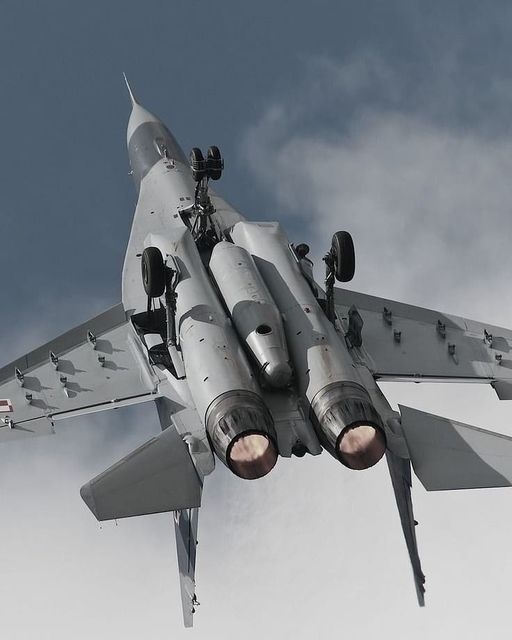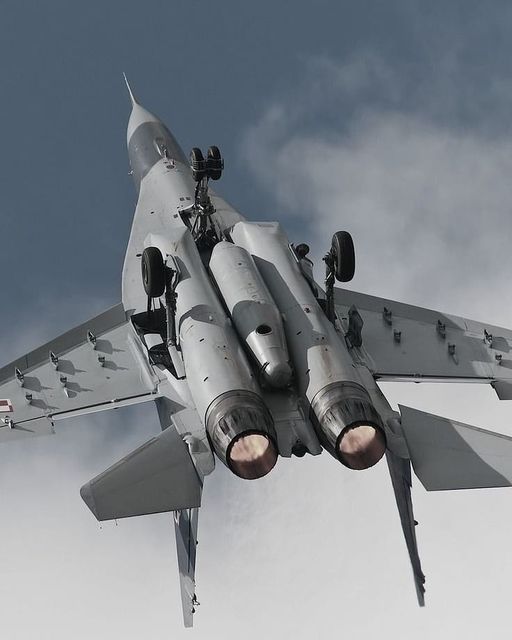
NATO pilots that practiced against the German Air Force Fulcrums found that in short-range dogfights at low speeds the MiG-29 was more agile than anything they threw at it.
Here’s What You Need to Remember: By the 1990s, Western pilots had ample opportunity to fly MiG-29s as the German Air Force incorporated the MiG-29s of East Germany. Later, the United States even bought twenty-one from Moldova.
The MiG-29 Fulcrum was the first Russian fourth-generation jet fighter, marked by its sleek and deadly appearance in contrast to earlier Soviet fighters. The fast and agile Fulcrum could outturn any NATO fighter, and it was armed with cutting-edge missiles. But, alas, it was held back by its old-fashioned electronics, short service life and limited range.
In a sense, the MiG-29 combined fourth generation engineering with third generation hardware. It’s relatively low price meant it initially attracted extensive sales to developing countries, but it would swiftly become overshadowed by the more modern Su-27. The Fulcrum will remain in service for some time, however, as recent upgraded versions partially redress some of its shortcomings.
Characteristics
The MiG-29 began development in 1974, intended to be an advanced lightweight multirole fighter that would operate from primitive airfields at the frontlines of the Cold War, while smaller numbers of heavier Su-27s (also then in development) would handle longer-range missions. This paralleled the light–heavy force structure of F-16s and F-15s being developed for the U.S. Air Force.
The first MiG-29s became operational in 1982 and were codenamed “Fulcrums” by NATO—a name which caught on with some Russian pilots as well. The Fulcrum had a fearsome reputation in the West, and even got its own computer game. By the 1990s, Western pilots had ample opportunity to fly MiG-29s as the German Air Force incorporated the MiG-29s of East Germany. Later, the United States even bought twenty-one from Moldova.
It was discovered that the Fulcrums were very hot rides—but they also had significant downsides.
The MiG-29’s twin RD-33 turbofan engines gave it excellent acceleration and a top speed of Mach 2.25—faster than the F-16 but a bit behind the larger F-15. The MiG-29’s chief claim to fame is its superb maneuverability—it can even outperform the light-footed F-16 in both instantaneous and sustained turns (twenty-eight degree per second versus twenty-six). NATO pilots that practiced against the German Air Force Fulcrums serving in JG 73 found that in short-range dogfights at low speeds the MiG-29 was more agile than anything they threw at it.
Like the Su-27, the MiG-29 is supermaneuverable—it can execute maneuvers impossible with regular aerodynamic controls because of its excellent handling characteristics following a stall. It can also attain very high angles of attack.
One other advantage of the MiG-29 was the short-range R-73 (NATO codename AA-11 Arrow) infrared-guided missile that could be aimed and fired through a helmet-mounted sight. Normally, a plane has to be pointed at an enemy fighter to target it—with the R-73, the pilot need only look at a target within sixty degrees of the frontal arc to shoot a missile at it! The U.S. Air Force did not acquire a similar capability until the AIM-9X entered service in 2003.
In addition to the R-73, the Fulcrum’s seven hardpoints can equip R-27 medium-range missiles, and older R-60 missiles. Some have also been upgraded to fire R-77 long-range air-to-air missiles. Up to eight thousand pounds of air-to-ground munitions can be carried—a significantly lighter load than peer fighter aircraft.
Finally, the MiG-29 is designed to function while operating from unprepared airstrips (presumably captured by advancing Russian tank divisions!)—its air intakes are specially protected against debris.
However, intrinsic design limitations of the MiG-29 have prevented it from aging well.
While aerodynamically outstanding, the MiG-29 did not feature modern pilot displays, controls and fly-by-wire avionics. Fulcrum pilots were required to stare down at their cockpit instruments far more than those of Western fighters with modern Head’s Up Displays, and the throttle was not integrated into the stick.
The MiG-29’s sensors were mediocre—its N019 Phazotron pulse-doppler radar had a shorter accurate range (thirty-eight miles) than the missiles the MiG-29 carried. Though equipped with an infrared sensor (IRST), pilots reported it to be of limited effectiveness.
These limitations in part reflected Soviet doctrine in which pilots were intended to be closely directed by ground controllers, so their situation awareness was less of a priority. The lack of modern electronics was what ultimately led the German Air Force to retire its Fulcrums, despite being more agile than their F-4s and Tornados.
Another major limitation is the MiG-29’s limited range of less than nine hundred miles on internal fuel and lack of inflight refueling ability—making it primarily useful as a defensive fighter, or one operating above frontline forces. While the Fulcrum may be a bargain for a less wealthy country worried about conflict on its borders, it has less appeal to air forces looking to project power over distance.
Finally, like most Soviet-era fighters, while the MiG was designed to withstand rugged handling, it wasn’t intended to have a long service life—just two thousand five hundred hours compared to the six thousand that is typical of U.S. fighters. MiG-29 airframes deteriorated rapidly later in life, and have required extensive and expensive maintenance to keep flying. Malaysia once reported it spent $5 million per year per MiG-29 to keep them flyable.
Variants
1,600 MiG-29s have been produced in all. Originally, the Fulcrum came in just a few variants: the standard single seat model and a two-seat trainer variant (MiG-29UB) without the radar. A downgraded version, the MiG-29B was exported abroad.
In the 1980s the upgraded MiG-29S appeared, featuring an active jamming system behind the cockpit (giving it a hunched back appearance), improved computers and software and modestly increased fuel and weapons load. Support for new R-27E and R-77 missiles was added.
In 1990, the next-generation MiG-29M (once known as the MiG-33) debuted, bringing the Fulcrum up to modern standards with fly-by-wire avionics. With a lighter airframe and more powerful smokeless engines (for lower visibility), the MiG-29M nonetheless appears to be slower (Mach 2 at high altitude) and has a lower service ceiling of fifty thousand feet, perhaps because its weighs an extra 1.25 tons. Internal fuel has been expanded for an improved range of over one thousand two hundred miles, a third drop tank can be carried, an inflight refueling probe is included. Two hardpoints are added, and the maximum payload is increased over 50 percent to twelve thousand pounds. Rounding out the package is an improved IRST system and an N010 Zhuk-ME pulse-doppler radar with a range of seventy-five miles against targets with a radar cross-section of five meters.
The MiG-29M was not accepted into Russian service, but it is believed Egypt will receive fifty later this year in a $2 billion contract ($40 million each). Sales to Syria and Serbia are also possible.
The Russian and Indian air forces have instead opted to use older Fulcrum airframes refitted to the MiG-29M’s standards, called the MiG-29SMT or the MiG-29UPG in Indian service. The SMT and UPG Fulcrums have their service life extended to four thousand hours, but weapons loads are not quite equal to the MiG-29M’s specifications. India’s upgrades cost roughly $13 million per airframe, and include foreign avionics.
In 2008, Algeria rejected a batch of thirty-four SMTs as they used old airframes in poor condition rather than newly produced ones stipulated in the contract. The rejected airframes were then put into Russian service and sixteen new ones were ordered. Russia intends to maintain a fleet of sixty MiG-29SMTs.
There are numerous Fulcrum variants tailored to the requirements of various air forces. The most notable is the MiG-29K, a navalized derivative of the MiG-29M operated both by the Russian Navy onboard the carrier Admiral Kuznetsov, and the Indian Naval Air Arm. The MiG-29K has folding wings, reinforced landing gear and an arrestor hook for carrier operations. The K also has upgraded pilot displays and radar-absorbent coatings to reduce its radar signature.
The (Painful) Track Record
Few fighter planes have managed to be so beloved and yet boast such an unfavorable combat record as the MiG-29. Of course, this is in large part because the Fulcrum was usually fielded by less developed countries against Western opponents that were more numerous, better trained, and better organized.
Setting the tune of things to come, in the Fulcrum’s first confirmed aerial combat, two Syrian MiG-29 were shot down by Israeli F-15s in 1989. There are reports Israeli fighters shot down another two Syrian MiG-29s in 2001.
During the Gulf War, five Iraqi MiG-29s were shot down by American F-15s. However, a Fulcrum did successfully hit an F-111 and a B-52 bomber with missiles, though both aircraft managed to return to base.
Fulcrums also took a beating in the Ethiopian–Eritrean border conflict of the late 1990s, which featured more evenly matched opponents. Russian mercenaries flew alongside Ethiopian pilots, while Ukrainians supported the Eritrean Air Force. In all, four Eritrean MiG-29s were shot down by Ethiopian Su-27s. In exchange, the Eritrean Fulcrums shot down a Su-25, a MiG-21 and an unidentified fighter (possibly a MiG-23). Over multiple engagements, Flankers and Fulcrums exchanged over two-dozen R-27 missiles at long range for only a single hit. Instead, most of the victories were scored in short-range dogfights using AA-11 missiles.
Sixteen MiG-29s of the Serbian Air Force opposed NATO’s bombing campaign over Kosovo in 1999. Deployed at medium altitude, where they were exposed to hostile radar, five were shot down by F-15s and F-16s without scoring any victories in return.
MiG-29s have also performed ground attack missions in the former Yugoslavia, Moldova, South Sudan, Sudan and Ukraine.
Russian Fulcrums have been involved in a few incidents over the years. In 1989, Soviet defector Alexander Zuyev absconded with a MiG-29 and flew it to Turkey in an incident involving a cake full of sleeping pills, a shootout with a security guard and a failed strafing run. A MiG shot down a Georgian drone in 2008 in an incident preceding the Georgian–Russian war. Ukraine claims a Fulcrum shot down a Ukrainian Su-25 over Eastern Ukraine in 2014.
Major Operators
Unlike the Su-27, the MiG-29 would see extensive service in NATO air forces after the end of the Cold War. While most have been retired, Poland retains a fleet of thirty-eight MiG-29s, and Bulgaria and Slovakia have nineteen and six respectively.
India has over 110 upgraded Fulcrums, including forty-five MiG-29Ks in the Naval Air Arm. Other notable operators include Algeria (26), Iran (25), Belarus (41), Kazakhstan (40), Myanmar (31), Peru (19), North Korea (35), Turkmenistan (24), and Uzbekistan (60).
MiG-29s are being actively used in combat in Ukraine—there were eighty before hostilities in 2014, but two have been shot down by rebel surface-to-air missiles—and Syria. Syria is believed to have fifteen to twenty operational MiG-29SMs upgraded by Russia with launch rails for deadly R-77 air-to-air missiles. Yemen’s nineteen or so MiG-29s were used in its counterinsurgency campaign, but have fallen into the hands of Houthi rebels and don’t appear to have flown since. Sudan’s twelve MiG-29s have been involved in raids against rebels in Darfur and the new state of South Sudan in 2012.
A two-seat Fulcrum with further modernized systems, the MiG-35, represents the Mikoyan firm’s latest bid to return to prominence in military aviation.
